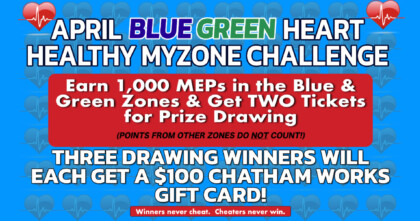News & Updates
April BLUE/GREEN Heart Healthy Myzone Challenge

We're big believers in the benefits of having variety in your training / exercise regimen to challenge your body and brain in different ways, and realize the benefits of different training protocols.
Training at lower intensities offers a number of significant health and performance benefits that you simply can't get from more intense exercise.
Top coaches for elite endurance athletes have long understood this. And aerobic base work is also a mainstay of the training programs of athletes who compete in shorter, more intense sports like rowing and mixed martial arts.
So to encourage our members to devote more attention to aerobic base training - and avoid overtraining - the goal of our April Myzone Challenge is to earn 1,000+ MEPs (Myzone Effort Points) from the Blue (60 to 69% of max HR) or Green (70 to 79% of max HR) zones.
Everyone who meets this goal will earn two tickets for a drawing to win one of three $100 Chatham Works gift cards.
Happy exercising! And please read on for some additional information and tips.
_______________________
BACKGROUND:
The most significant benefits of so-called "Zone 2 Training" are:
- Stimulates Type 1 muscle fibers, which promotes mitochondrial density and health. Mitochondrial function has been shown to be positively correlated with longevity. It also improves our ability to utilize fat (and preserve glycogen).
- Leads to improvements in cardiac function by increasing oxygen delivery to muscles, reducing cardiac output at rest, and improving cardiac output during activity.
- Improves our ability to clear lactate, which boosts athletic performance.
Of course there are numerous benefits to higher intensity training too. But sometimes we tend to spend proportionally too much time working at higher intensities - perhaps because it's more stimulating (and generates higher levels of endorphins).
Spending too much time working at higher intensities is almost certainly not an optimal approach to training for most people. Here's why:
- You simply can't work at higher intensities too often without eventually plateauing, burning out, or getting injured. And these problems have become far more common as HIIT-focused workouts have gained in popularity. (Note that very few gyms offer "steady state cardio classes", because they're not popular ... even of they should be!)
- While the benefits of aerobic base work will definitely help improve your performance at higher (anaerobic) intensities, the reverse doesn't appear to be true. In other words, there's no substitute for working at "aerobic base" levels.
HOW TO DO IT:
Make it interesting. The only way to build your aerobic base is to put in the time. And that generally means "long, slow, steady cardio", 30 to 60+ minutes in duration. Here are some tips:
- Embrace it you might find that you can enjoy it! It's a great way to clear your head. Or make it "me time" and get lost in your favorite podcast or an audiobook.
- Grab a workout buddy to join you, and help keep each other accountable.
- Get outside and enjoy Spring on Cape Cod! (When weather allows, that is ...)
- Mix in intervals to introduce some variety (but try to avoid letting your heart rate creep above 85% of max).
For the purposes of the challenge, you'll want to stay within the Blue (60 to 69% of max HR) or Green (70 to 79% of max HR) zones. But here's some additional guidance:
- You want to be working at an effort level where talking isn't a problem, but is perhaps slightly strained. Anything beyond that and you're likely transitioning out of the aerobic energy system.
- In terms of heart rate, you should shoot for somewhere between 70 to 80% of your maximum heartrate. This is the Green zone for Myzone, but this can vary so it's best to err on the low side - especially when you're starting out.
- BONUS TIP: One way to keep yourself from creeping into higher heart rate zones is to keep your mouth closed and breathe only through your nose. So-called "nose breathing" has a number of other very powerful benefits, including increasing your oxygen uptake and circulation, promoting relaxation, and increasing your aerobic efficiency and athletic performance. (BONUS TIP: Try two quick inhales, followed by a longer, slower exhale.)
Additional Reading:
NYT: "The Benefits of Moderate Exercise"
Various resources about "Zone 2" Training by noted longevity expert Dr. Peter Attia, MD.
Zone 2 Training Benefits by Dr. Iñigo San Millán, Ph.D., - Director of the Exercise Physiology and Human Performance Lab at the University of Colorado, and Performance Coach to numerous elite athletes in multiple sports.
Interval Training Masterclass (video) by noted Strength & Conditioning Coach Joel Jamieson, who has specialized working with MMA fighters. (Click here for a quick summary.)
Myzone: The Blue & Green Zones
Benefits of Nasal Breathing, & How To Breathe During Exercise (video), with Stanford Neurologist Andrew Huberman, PhD
WaPo: Could Nasal Breathing Improve Athletic Performance?
The Buteyko Breathing Method (via Boston Medical Center)